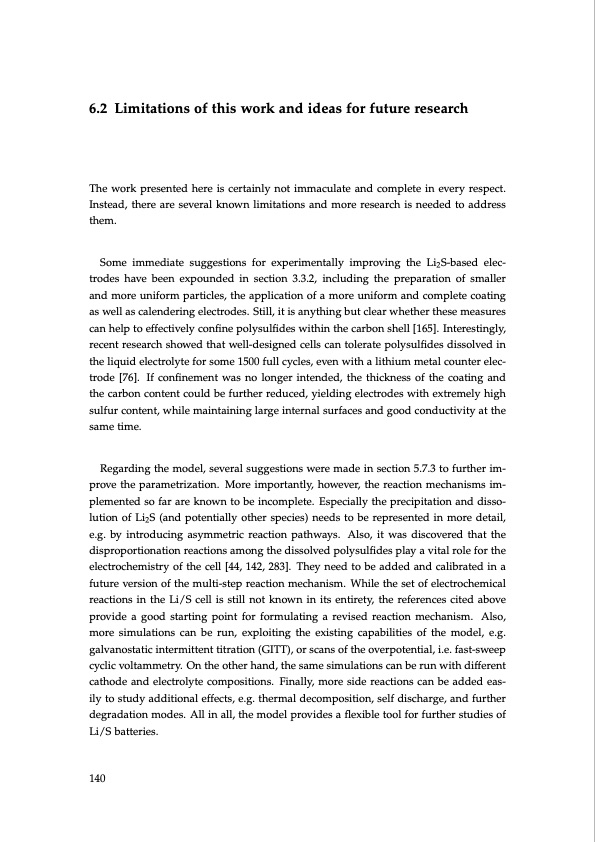
PDF Publication Title:
Text from PDF Page: 140
6.2 Limitations of this work and ideas for future research The work presented here is certainly not immaculate and complete in every respect. Instead, there are several known limitations and more research is needed to address them. Some immediate suggestions for experimentally improving the Li2S-based elec- trodes have been expounded in section 3.3.2, including the preparation of smaller and more uniform particles, the application of a more uniform and complete coating as well as calendering electrodes. Still, it is anything but clear whether these measures can help to effectively confine polysulfides within the carbon shell [165]. Interestingly, recent research showed that well-designed cells can tolerate polysulfides dissolved in the liquid electrolyte for some 1500 full cycles, even with a lithium metal counter elec- trode [76]. If confinement was no longer intended, the thickness of the coating and the carbon content could be further reduced, yielding electrodes with extremely high sulfur content, while maintaining large internal surfaces and good conductivity at the same time. Regarding the model, several suggestions were made in section 5.7.3 to further im- prove the parametrization. More importantly, however, the reaction mechanisms im- plemented so far are known to be incomplete. Especially the precipitation and disso- lution of Li2S (and potentially other species) needs to be represented in more detail, e.g. by introducing asymmetric reaction pathways. Also, it was discovered that the disproportionation reactions among the dissolved polysulfides play a vital role for the electrochemistry of the cell [44, 142, 283]. They need to be added and calibrated in a future version of the multi-step reaction mechanism. While the set of electrochemical reactions in the Li/S cell is still not known in its entirety, the references cited above provide a good starting point for formulating a revised reaction mechanism. Also, more simulations can be run, exploiting the existing capabilities of the model, e.g. galvanostatic intermittent titration (GITT), or scans of the overpotential, i.e. fast-sweep cyclic voltammetry. On the other hand, the same simulations can be run with different cathode and electrolyte compositions. Finally, more side reactions can be added eas- ily to study additional effects, e.g. thermal decomposition, self discharge, and further degradation modes. All in all, the model provides a flexible tool for further studies of Li/S batteries. 140PDF Image | Lithium-Sulfur Battery: Design, Characterization, and Physically-based Modeling

PDF Search Title:
Lithium-Sulfur Battery: Design, Characterization, and Physically-based ModelingOriginal File Name Searched:
Dissertation_David_N._Fronczek_The_Lithium_Sulfur_Battery.pdfDIY PDF Search: Google It | Yahoo | Bing
Sulfur Deposition on Carbon Nanofibers using Supercritical CO2 Sulfur Deposition on Carbon Nanofibers using Supercritical CO2. Gamma sulfur also known as mother of pearl sulfur and nacreous sulfur... More Info
CO2 Organic Rankine Cycle Experimenter Platform The supercritical CO2 phase change system is both a heat pump and organic rankine cycle which can be used for those purposes and as a supercritical extractor for advanced subcritical and supercritical extraction technology. Uses include producing nanoparticles, precious metal CO2 extraction, lithium battery recycling, and other applications... More Info
| CONTACT TEL: 608-238-6001 Email: greg@infinityturbine.com | RSS | AMP |